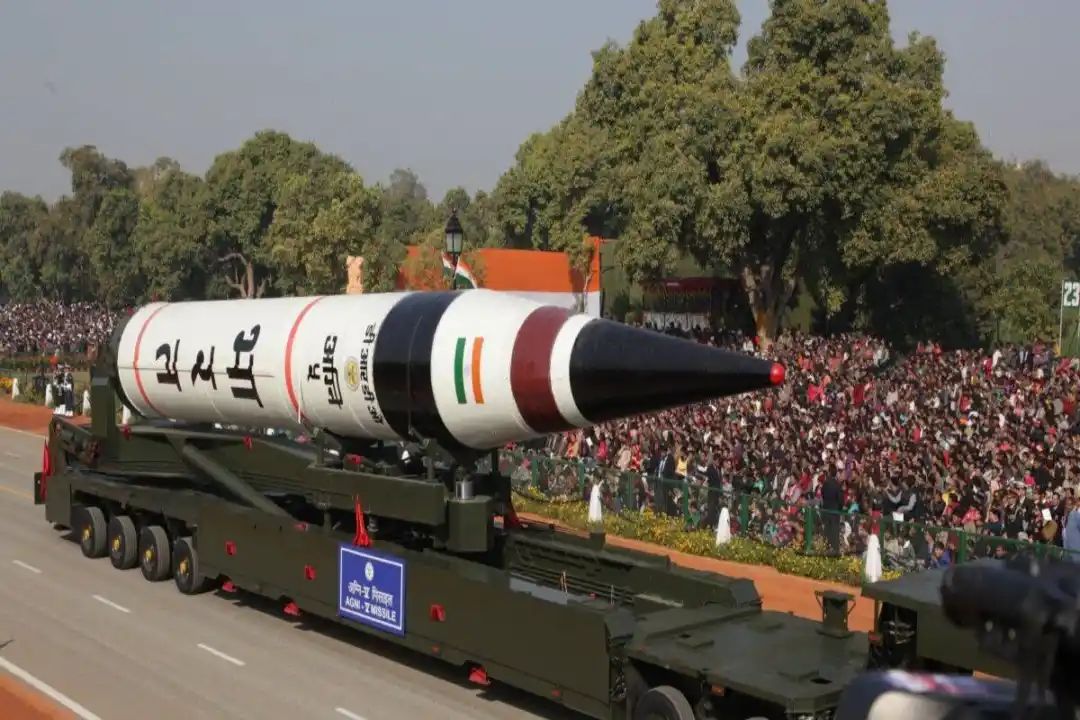The Agni-V missile was tested by the Strategic Forces Command. The test marks the formal introduction of the missile into the Indian arsenal as it is the first night-launch of the missile.
This test now means that India’s Strategic Forces Command has a force of land-based ballistic missiles which include the Prithvi SRBM, the road-mobile Agni-I MRBM, the rail mobile Agni-II IRBM, the rail-mobile Agni-III IRBM, the road-mobile Agni-IV IRBM and the road-mobile Agni-V ICBM.
While the first two launches of the Agni-V – on 19th April 2012 and 15 September 2013respectively – were of the standard Indian uncanisterised missile, the tests starting on 31st January 2015 and later26th December 2016 were of a canisterised system mounted on a road mobile platform. In 2018, three tests of the Agni-V were conducted on,18 January, 3 June and 10 December. On each occasion, the cannister variant was tested by the SFC, in all probability indicating not only an IOC but also the real likelihood that the production of the missile is in progress. This most recent test seems to confirm both the production of the system and its induction into the Indian arsenal.
As an operational weapon, the Agni-V is armed with a nuclear warhead, in tune with India’s concept of a credible minimum deterrent and one which would be survivable in the event of a hostile first-strike, as India has a strict no-first-use nuclear doctrine. The Agni-V would most probably be armed with a large-yield fusion or boosted-fission warhead with a yield of in excess of 200 kilotons, perhaps reaching 500 kilotons. As a road-mobile weapon, the Agni-V is very survivable and can easily be concealed from enemy surveillance, being deployed only when ready to fire. Its road mobility makes it much more flexible than the Agni-II and Agni-III missiles which were rail mobile and rail-launched.
Officially, the Agni-V has a range of “greater than 5000km”. This is quite typical of DRDO’s normal statement on range but even this figure places all of China within range of the Agni-V. This figure is a definite understatement given the dimensions and the published performance parameters of the Agni-V, with its Mach 24 velocity and its trajectory arc. What should continue to raise eyebrows is the persistent suggestion, backed by calculations based on flight time, speed and altitude of the Agni-V, that the range of the missile is in reality anywhere between 7500km and 8500km – as claimed by Chinese analyst Du Wenlong. It would be fair to term the Agni-V an intercontinental-range ballistic missile (ICBM) because the range of 5500 km is the demarcation line between IRBMs and ICBMs in the normal use of the term reflecting roughly the transatlantic distance between the Iberian Peninsula (or London) and the East Coast of the United States. Is India varying trajectories to simulate much longer-ranges? This is a distinct possibility.
The Agni-V is, so far, the ultimate evolution of the Agni family. It combines the road mobility of the Agni-I and Agni-IV with the configuration of the Agni-III but improves upon the latter redesigning the missile and making great use of maraging steel and composite materials to make the rocket motor. Moreover, improvements in the guidance system reputedly brought down the CEP to “single-digits”. With these improvements in place, the Agni-V is now ready to enter production and induction into the SFC which will then undertake user trials – starting with “user-assisted” trials and then, as with the case with Agni variants I-IV, the SFC then took over subsequent trials.
The Agni-V also marks, through its use of a canister-launched missile, a shift in India’s missile deployment approach as the warheads for such missiles would have to be mated before the missile is sealed into its canister. This is in contrast to the road and rail mobile Agni-I through Agni-IV. India’s shift in approach is also evident in the recent Agni-Prime test which also used a canister launched missile. This has, of course implications for India’s nuclear deterrent which some analysts had assumed would consist of de-mated warheads in peacetime. However, as the Agni-V and Agni-Prime will need to be sealed into their canisters, this de-mated approach would be completely inappropriate. Is India therefore moving to keeping a proportion of its arsenal in fully operational configuration?
This approach would make perfect sense for a viable second-strike capability. It should come as no surprise that India is taking this approach to the deployment of its land-based missiles as it moves towards establishing a submarine based nuclear deterrent – with INS Arihant in commission and INS Arighat undergoing trials. In the case of the Indian SSBN force, the fitting of nuclear warheads to their K-15 and K-4 SLBMs would also be required as de-mated warheads are completely impractical for submarine deployment.
The future of the Indian land-based ballistic missile deterrent is likely to focus on increasing production and deployment of the Agni-Prime, the Agni-IV and Agni-V missiles with probable refinements to the accuracy of the two systems. Successors to the two missiles may take the form of longer-ranged and, in the case of the Agni-IV, being canister launched. The development of a full-fledged ICBM is either already done with the Agni-V (given speculations over its true maximum range) or a question of priority. However, one may expect that a longer-ranged missile with MIRVs may be on the horizon in the relatively near future.
Yet, the survivability of India’s deterrent, it’s no-first use doctrine and its requirement for a robust second-strike capability requires that India’s nuclear triad be fully operationalized and viable against its likely adversaries. To this end, India’s air-delivered nuclear weapons – presumably now delivered by either Mirage 2000I/TI, Rafale or Su-30MKI platforms – need to be enhanced with stand-off air-launched cruise missiles. This can be done by either taking the step of miniaturizing a nuclear warhead to fit the Brahmos missile or by developing a dedicated ALCM. It, of course, goes without saying that the submarine-based deterrent must be operationalized without undue delay.



